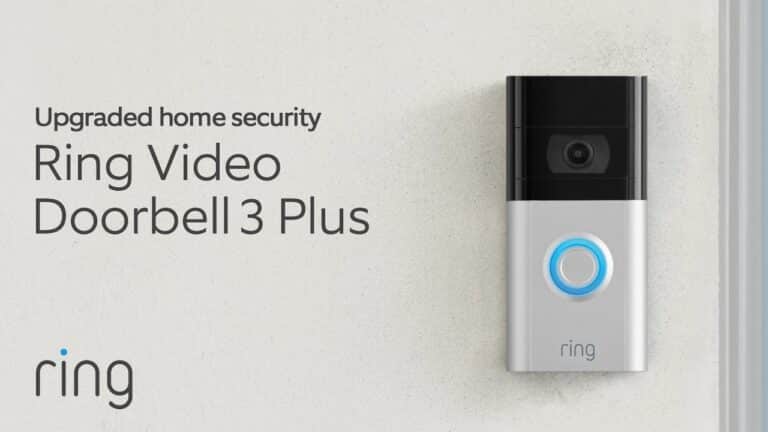This Ring Video Doorbell 3 Plus tackles one of the most common complaints about video doorbells. The challenge: capturing everything that happens when a person enters the image, whether it’s a visitor or not. The individual may be halfway through the frame by the time the motion sensor recognizes movement & instructs the camera to start recording, so all you see is the back of their head.
The solution is considered Pre-roll, and it allows you to see the four seconds before anyone enters the picture on the Ring Video Doorbell 3 Plus. This isn’t a new feature; some of the top video doorbells already have it, but it’s nice to see Ring catching up. Ring’s video doorbell is the only one that can do it on battery power alone among video doorbells with this feature.
However, as you’ll see in this Ring Video Doorbell 3, there are a few areas where Ring falls behind the competition.
What you will see here?
Design
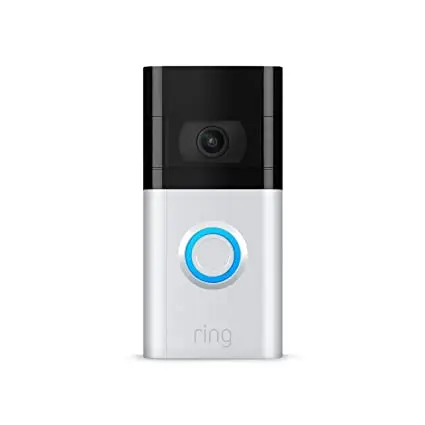
There aren’t any substantial changes here. This Ring Video Doorbell 3 Plus (as well as the Ring Video Doorbell 3) resemble their predecessors, namely Ring Video Doorbell 2 or the Ring Video Doorbell, in appearance. The camera is housed in the top third of the rectangle, which is glossy black and is 5 inches in height, 2.4 inches wide, and around 1 inch deep. A plastic silver cover covers the lower two-thirds of the doorbell’s button (Ring sells a bronze-colored cover).
Ring’s doorbell cam contains a battery, allowing it to be deployed without the use of wires. Its Video Doorbell 3 is thicker than other wired doorbell cams like the Nest Hello as well as the Arlo Video Doorbell due to the battery.
Setup
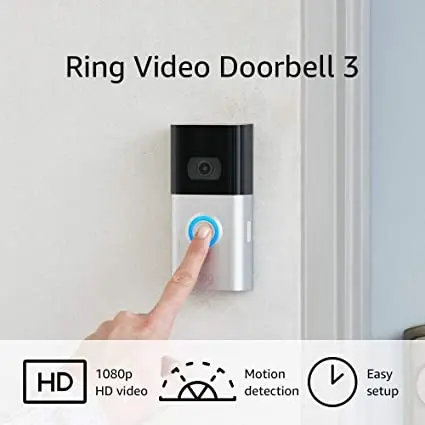
One of the things you appreciated about the first Ring Video Doorbell is that it has required the installation of a lightweight base plate to which the power lines were connected. The camera doorbell was then slipped into place and attached to a base plate. This method attracted you since it was simpler to complete on your own, and you didn’t have to worry about the video doorbell’s full weight yanking on the wires until you screwed it all in.
This Ring Video Doorbell 3 Plus, like some other video doorbells, doesn’t come with a base plate, so you’ll have to attach the wires straight to the back of a doorbell. Because there’s less space in the back, You had to work extra hard to get my doorbell’s cables into place. This Ring Video Doorbell 3 does have a beefier security bolt than the previous model, which you enjoy.
Two plastic wedges are included with the doorbell, one that angles the camera more toward the center of your door and the other that angles the camera downward.
Ring’s Chime ($29) and Chime Pro ($49) are two additional useful extra features. All those are wireless doorbell bells that may be linked to your video doorbell so that they ring when someone hits the doorbell button. You’ll know if someone is at the door even if you don’t have your phone with you. You can also set the Chime to ring when the doorbell detects movement. The Chime Pro also doubles as a Wi-Fi extender for video doorbells, which comes in handy when their home wireless network can’t quite reach the front door.
Pre-roll
The new Ring Pre-roll feature is identical to those of the Nest Hello, Arlo Video Doorbell, & August Doorbell Cam. Essentially, every one of these cameras is caching a few seconds of footage at all times; so when the doorbell detects activity (and records it), the stored video is added to the beginning of the recording. That way, you’ll have a better possibility of seeing someone approaching your door.
Ring’s Pre-roll, on the other hand, works even though the doorbell is powered by batteries, unlike its competitors. The Nest Hello, Arlo, & August all are wired-only video doorbells, for what it’s worth. The pre-roll film is captured at a lesser resolution and also in black-and-white to save battery life. Furthermore, only the middle horizontal segment is in focus, so identifying someone up or down that area will be difficult. Also, when the camera is in night vision mode, Pre-roll does not operate.
When you watched the Pre-roll film, It felt like you were watching Dorothy leave her house and enter Oz for the first time in The Wizard of Oz, only it wasn’t quite as amazing. It’s adequate, but if you don’t require a wireless doorbell, similar function on the Nest and Arlo is far superior.
The hardwired-only Ring Video Doorbell 3 Pro ($249) also includes a Pre-roll feature, but still, it records everything in color and at full definition.
Video Performance

This Ring Video Doorbell 3 Plus boasts a 1080p camera with either a 160-degree field of vision, the same as the Ring Video Doorbell 2. It provided a good, panoramic picture of the front stoop. But it didn’t show the area of the porch nearest to the door. The most likely spot for a package to be dumped. The Ring video’s bottom edge was roughly four feet from the door, two feet further than the Arlo. The provided wedge helped a little. But you’ll need a camera such as the Maximus Answer DualCam if you truly want to see what’s at the bottom of your door.
Aside from that, you were usually impressed with Ring’s video quality, both day & night. While the clarity was not the best—tree leaves and darker regions appeared mottled, especially when moving in the breeze—you were able to make out people’s faces and features. The HDR option on the Ring Video Doorbell 3 Plus compensated for the contrast between the darkness of the covered porch and the brilliant sunlight sky beyond.
App and features
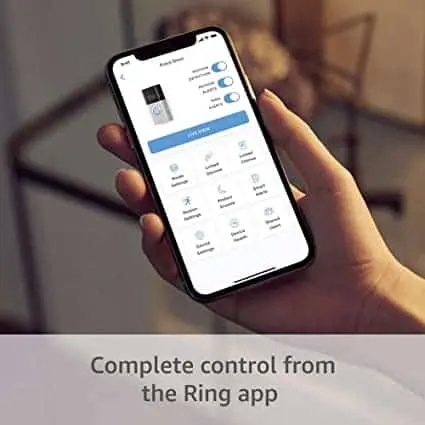
When you receive a notice from Arlo’s video doorbell, you enjoy that a still picture from the doorbell appears on my iPhone’s lock screen. It’s a quick and simple approach to see if it’s just the mailman, a visitor, or someone else. You have a notification that someone is at your door with the Ring, but no picture, so you have to open the app to see who’s there.
The Ring app offers a Motion Wizard that asks you a few things. Such as how near you are to a roadway, and then tries to customize the motion settings for you to reduce annoying alerts as much as possible. It’s simple to do and rather effective.
You can also tweak the sensitivity and establish schedules when motion alerts are active. As well as manually pick or deselect one of 4 categories for the camera to ignore. It’s beyond me why it doesn’t have the greater flexible motion area options that the Ring Video Doorbell Pro has.
Person Detection is a wonderful new function on the Ring Video Doorbell 3 Plus. If enabled, you should receive notifications only when someone approaches your door. (It will, however, continue to record all motion occurrences.) You enabled Person Detection as a test. But configured the camera to detect motion the all way to the street next to the house. It set the motion sensor to its most sensitive setting. While the Ring 3 Plus diligently captured every car that passed by, it only informed me when a person entered the scene.
Package detection
Package detection, which is featured on the Arlo Video Doorbell as well as the Nest Hello, is still missing from the Ring Video Doorbell 3 Plus. While Ring has been rumored to be experimenting with features, there is no facial recognition, unlike Nest Hello. Although some may find this unsettling, knowing when family members return home could be useful.
Privacy Zones, a function that allows you to block out areas of the Video Doorbell 3 Plus’ vision so that you don’t record their property, will be appreciated by your neighbors.
Ring’s video doorbells & home security cameras will have end-to-end encryption starting in July 2021. Unfortunately, battery-powered devices, like the Ring Video Doorbell 3, do not have this capability.
Subscription costs
To get the most out of the Ring Video Doorbell 3. You’ll need to pay a subscription, as is the case with most smart home security gadgets.
You could get notifications and watch a live feed from the webcam if you don’t join up. But that’s about all. It’s ineffectual since the person at the door has most likely already left by the time you make a notification.
Subscriptions for a single camera start at $3 per month or $30 per year and include 60 days of continuous rolling cloud storage. The Ring Protect Plus package ($10/month, $100/year) covers an unlimited number of sensors at any one place. This includes home security cameras as well.
When compared to other security cameras, that’s a really good deal. Arlo Premier, for example, costs $3 per month for a single camera or $10 per month for up to 5 cameras; discount additional cameras by 50%. Nest Aware comes with 30 days of footage storage, is $6 per month (or $60 per year), and supports an infinite number of cameras.
Security and Privacy
Without least a brief discussion of the company’s prior privacy and security concerns, any Ring device featuring a camera would be remiss. In 2019, Ring was plagued by reports of people hacking into its cameras. The vast majority of whom were caused by weak passwords. Ring now mandates two-factor authentication for any and all users and simplifies its privacy regulations in the app. It makes it easier to opt-out of data sharing with third parties.’
Some people are also concerned about Neighbors. A Ring app feature that allows you to share videos from your Ring cameras with others. In the Neighbors app, you and also view videos that others have shared. It’s used to notify people in your neighborhood about things like crime, safety, unusual visits, lost pets, and “neighborly moments”—good deeds. Use the Neighbors program by a variety of local law enforcement agencies in the United States. However, individuals are not obligated to share their footage or information with authorities. Unless they order to do so by a court order. You can also opt-out of getting requests via the Ring app.
Compatibility with Smart Homes
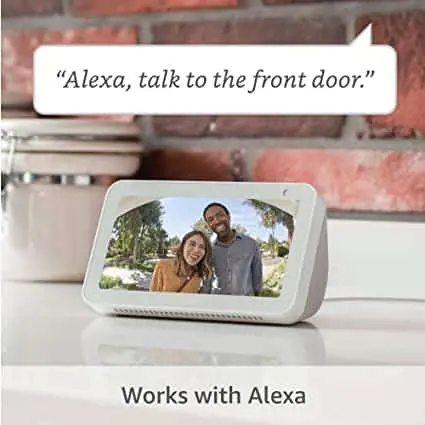
It’s no surprise that Ring Video Doorbell 3 Plus works well with Alexa, given that Ring own by
The ring has expanded its offerings since the initial video doorbell to include smart lights. As well as the Ring Alarm home security system. You may set the doorbell cam to start recording automatically whenever your Ring smart lights detect motion.
A Schlage Encode smart lock, and also Smartlink, Kevo, ADT Pulse, WeMo, and Wink. Seems to be Video Doorbell 3 Plus compatible with all of them?
Price and release date

In 2020, introduce the Ring Video Doorbell 3 ($199) & Ring Video Doorbell 3 Plus ($229), and they are nearly identical. The primary difference is Pre-Roll technology, which adds a low-resolution, black-and-white 6-second preview pane of each motion event to the Plus.
Conclusion
The Ring Video Doorbell was the first video doorbell, and it set the benchmark for video doorbells. However, the Ring Video Doorbell 3 Plus is a great device that deserves to there among the top video doorbells. There are still just a few things that the competitors do better.
You like that the Ring 3 Plus’ Pre-roll now allows you to view more of what’s going on. But it’s not as good as other video doorbells’. The only difference is that Ring’s power by battery, which deal-breaker for some.
If you’re looking to replace a hardwired doorbell with a Ring device, the Ring Footage Doorbell Pro; it’s $20 more costly, but you do get full color and high-resolution video for Pre-roll. The Ring Video Doorbell 3 Plus, on the other hand, is a terrific wireless doorbell.
Read more:
- Eufy Video Doorbell Dual: A Closer Look at your guests and packages!
- Best Charging Stations for Arlo Pro and Arlo Pro 2 in 2021!
- Ringly Review- The stylish designer tech smart ring!


